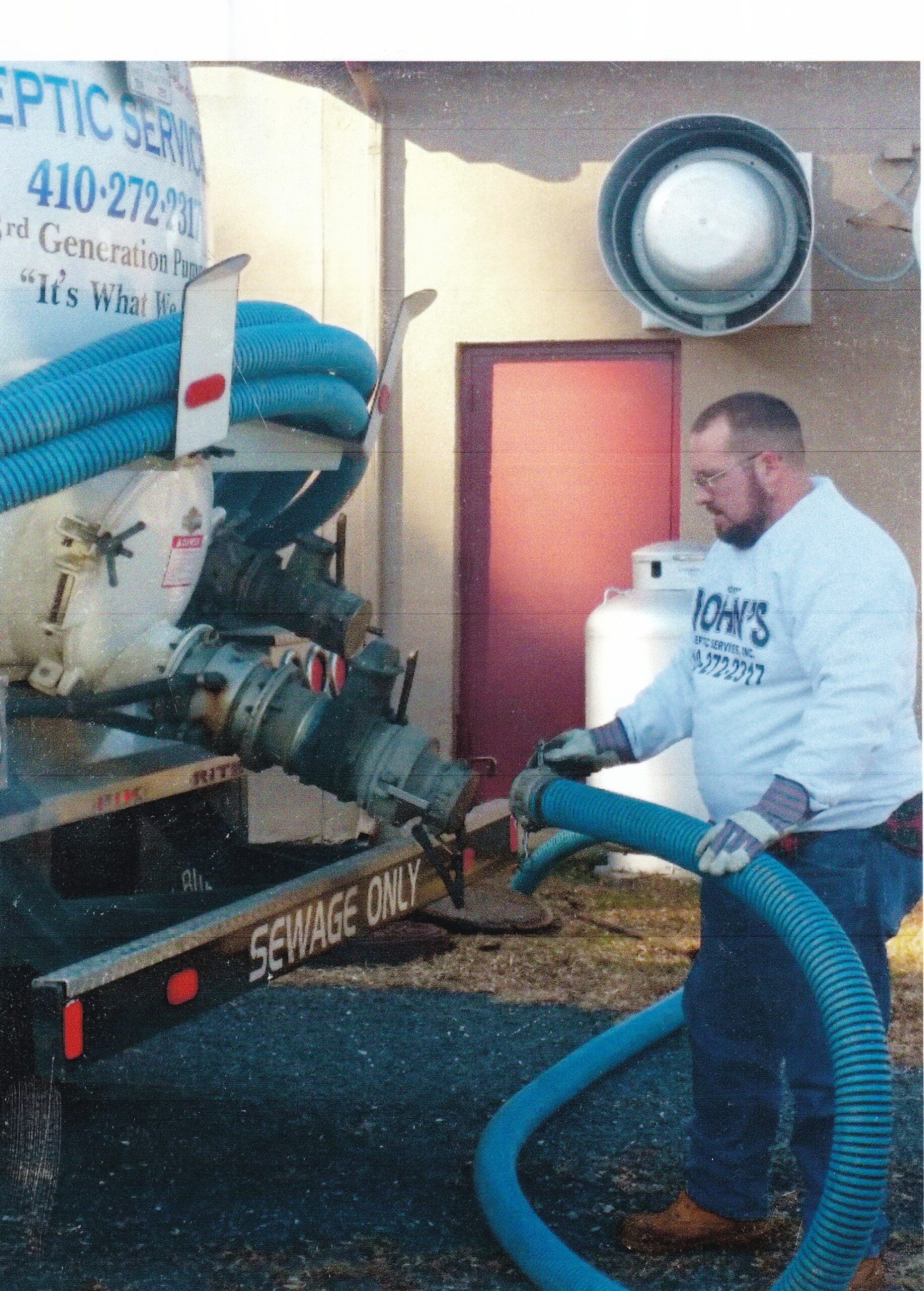
Efficient Septic Tank Pumping for a Clean and Healthy System
John’s Septic Service has been performing septic tank pumping since 1969. We know our stuff. We utilize modern, sanitary equipment and we take every precaution to protect your property. Each large capacity pump truck is equipped with 200 feet of hose, allowing us to park away from the drainfield and away from your home during the septic tank pumping process.
Homeowners should avoid using septic tank additives unless recommended by a professional, as they can cause harm to the system. Alternative systems, which have mechanical components, require more frequent inspections. It is crucial to remove heavy solids from the bottom of the tank during pumping to maintain efficiency. Bacteria in the septic tank break down solid materials and greasy scum over time, but removing solids is essential to prevent clogging in the soil absorption field. Informing contractors whether the system is conventional or alternative helps them prepare effectively. Understanding what goes down the drain is vital for system health, and maintaining proper drainage prevents clogging in the drainfield. The scum layer, which includes fats, oils, and grease, plays a critical role in the system. Knowing how frequently septic tanks should be maintained and inspected is important. Removing greases from the top of the septic tank during pumping is necessary. Certain household behaviors can harm the system, so homeowners must be diligent in their maintenance. The liquid layer in the septic tank flows out to the drainfield for further treatment. Regular removal of solid material is needed to keep the system functioning. The oil layer in the septic tank is part of the scum layer. Pipes transport wastewater from the septic tank to the soil. Wastewater must separate into three distinct layers for proper treatment. Bacteria help break down solid material within the tank. Toilets should not be treated as trash cans. Septic systems treat household waste using natural processes. Trenches in the system distribute effluent for effective management. Vehicles should not drive over drainfields to avoid damage. Inadequate maintenance can expose families to health hazards, including viruses.
Understanding Your Septic System
A septic system is a self-contained wastewater treatment system that uses natural processes to treat and dispose of household waste. It’s an essential component of many homes, especially in areas where a connection to a municipal sewer system is not available. Septic systems typically consist of a septic tank and a drainfield. The septic tank is where wastewater from the house enters and is separated into three distinct layers: scum, effluent, and sludge. The scum layer consists of lighter materials like grease and oils, the effluent layer is mostly water, and the sludge layer comprises heavier solids that settle at the bottom.
Homeowners with septic systems must be aware of their responsibilities in maintaining these systems. This includes monitoring the system’s performance, scheduling regular inspections and pumpings, and being mindful of what they dispose of through their plumbing to avoid clogging the system or harming the environment.
Septic System Maintenance: Key to Longevity, Efficiency, and Environmental Protection
Regular maintenance of a septic system is vital to extend its lifespan, prevent costly repairs, and protect the environment from potential pollution. The Environmental Protection Agency (EPA) recommends that septic tanks be inspected every three years and pumped as necessary, usually every 3 to 5 years. This depends on factors such as tank size, household size, and water usage. Proper maintenance also involves being cautious about what is flushed down the toilet or drains. Avoid disposing of items that can clog the system or disrupt the balance of bacteria and other organisms essential for wastewater treatment, such as sanitary products, chemicals, and excessive amounts of grease.
Homeowners should keep records of their septic system’s maintenance, including pumping schedules, inspections, and any repairs. This ensures compliance with local regulations and provides a reference for future maintenance needs. By prioritizing septic system maintenance, homeowners can prevent premature system failure, reduce the risk of environmental contamination, and protect their investment in their property.
Septic Tank Pumping: Thorough Service, Expert Care, and Preventative Maintenance
When we arrive to perform septic pumping, our trained technicians, or Ministers of Muck, will unwind the flexible hose from the pump truck, and connect sections to reach up to 200 feet if needed. One end is connected to the vacuum truck and the other end is placed in the septic tank. When the septic tank is empty, we turn the truck pump to reverse, (or backflushing) to loosen anything left stuck in the tank. Again, the tank is pumped empty. At that point, you will be asked to flush your toilet and the technician will check for good steady flow from the house to the tank. Then we haul the contents of the tank, now safely in our pump truck, to the disposal plant. John’s Septic Service recommends a 2 year septic tank pumping schedule to help maintain your septic system and avoid system failure. Contact reputable service providers for septic tank pumping and maintenance to ensure the best care for your system. Proper pumping is essential to prevent scum and solids from floating out of the septic tank and causing issues. Commercial septic tank cleaners must keep records of waste disposal practices and make them available upon request. County boards of health are responsible for enforcing standards and licensing requirements related to septic tank services. Avoid planting trees or shrubs near drainfields to prevent root intrusion and damage to your system. Working with reputable companies for septic tank services is crucial for effective and safe handling of your septic system. Signs of septic system failure can include:
- Septic odors either indoors or outdoors close to the system
- Toilets fail to flush or back up – a worst case scenario is raw sewage backs up into your basement)
- Gurgling signs in pipes and drains
- Standing water or bright green, spongy grass in the area of the drainfield, even in dry weather
At each septic pumping appointment, we will perform a visual inspection to check for any issues, and make recommendations for repairs, if needed. Not sure where your septic system is located?
Use this file for some tips, and to fill out the diagram.
Pre-Pumping Preparation
Before scheduling a septic tank pumping, homeowners should prepare their system to ensure the process is efficient and effective. Start by clearing vegetation and soil from the septic tank and observation ports to facilitate easy access for the pumping service. It is also recommended to flag or mark the location of the septic tank to avoid additional fees for location and uncovering. Creating a simple map of the septic system, including the location of the tank, house, ports, distribution box, and drainfield, can guide the service provider.
Ensuring a clear pathway for the contractor’s vehicle to access the tank is crucial. Informing the contractor if the system is a conventional or alternative one can help them prepare the appropriate equipment and approach for the pumping service. Homeowners should also take this opportunity to inspect their plumbing fixtures and appliances for any leaks or inefficiencies that could be affecting their septic system’s performance. Addressing these issues before the pumping service can maximize the benefits of the maintenance.
Consequences of Septic System Neglect
Neglecting septic system maintenance can lead to severe consequences, including system failure, which can result in costly repairs or even the need for a completely new system. When a septic system fails, it can contaminate groundwater, posing serious health risks to humans and animals, and damage the environment. Failure to pump the septic tank regularly can cause solids to build up and eventually flow into the drainfield, clogging the soil pores and preventing the proper treatment of wastewater. This can lead to backups, odors, and further environmental degradation.
Moreover, neglected septic systems can become breeding grounds for disease-carrying organisms, posing a significant risk to public health, especially in areas with high water tables or nearby water sources. The financial and environmental costs of neglecting a septic system far outweigh the costs of regular maintenance. It is imperative for homeowners to prioritize the upkeep of their septic systems to prevent these consequences and ensure the system operates efficiently and safely.
![]() 510 S Stepney Road | Aberdeen, MD 21001
510 S Stepney Road | Aberdeen, MD 21001![]()
![]() 510 S Stepney Road | Aberdeen, MD 21001
510 S Stepney Road | Aberdeen, MD 21001![]()

